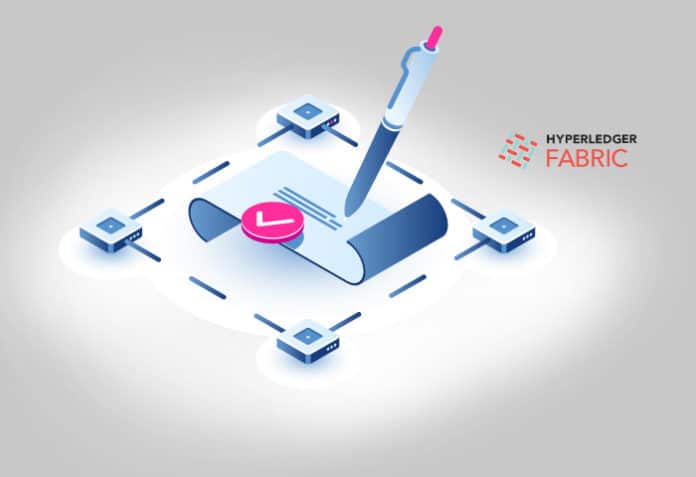The Hyperledger Fabric framework, offered as an open source project, facilitates the development of blockchain based applications, products and enterprise solutions. It offers plug-and-play components that simplify the development process while introducing new features.
Developed by the Linux Foundation, Hyperledger is a distributed ledger framework that was launched in 2015. This open source framework has a robust architecture and dynamic capabilities that make it ideal for enterprise use. Fabric (in Hyperledger Fabric) is highly efficient and scalable DLT (distributed ledger technology) fit for enterprise purposes. It was developed by IBM.
Hyperledger Fabric has strong provisions for optimising privacy and performance through its permission access design. It enables businesses to restrict the flow and visibility of information to specific members only, while also reducing the network nodes, which in turn speeds up the transactions.
Fabric 2.0, an improved version of the original product with the newest smart contract technology, faster transactions and other performance enhancing features, was released in 2020. Hyperledger Fabric, developed by IBM and Digital Asset, intends to boost workplace productivity by combining blockchain capabilities with enterprise-grade privacy and security. It is now hosted by the Linux Foundation.
In spite of the benefits, many businesses still hesitate to incorporate conventional blockchain networks into their daily processes because they are publicly accessible. For obvious reasons, businesses don’t want to share sensitive information or mission-critical business contracts. Hyperledger Fabric has been created to address this challenge. It is a high security foundation to facilitate enterprise blockchain solutions. It can be scaled and isolated to suit performance and privacy requirements of businesses.
Hyperledger Fabric allows verification of identities based on access permissions and enables membership authorisation or restriction, preventing unauthorised entry into the network by external entities. It also has strong technology for enabling companies to comply with government regulations on data protection like storing participants’ data and their detailed access history.
A few exclusive benefits of Hyperledger Fabric are briefly described below.
Modular architecture
The Hyperledger Fabric module design divides the transaction processing workflow into three modules: chaincode, transaction ordering, and transaction validation and commitment.
Hyperledger cleans up the network and allows simplified, smooth operations by lowering trust levels and simplifying verification. It also aids in boosting the network’s scalability and overall performance.
For example, once a rule based access module has been established, the company can reuse it for numerous identical cases, saving the time and effort needed to build the same module for each one.
The network participants assume three distinct roles:
- Endorser
- Committer
- Consenter
The number of endorsements required for a transaction proposal follows a predetermined guideline. As a result, this proposal gets sent to endorsing entities or peers. After receiving sufficient endorsements, the committers are handed the transaction block/batch to officially check that the standard endorsement procedure has been followed and that no different transactions have been discovered. The transactions are finally committed to the ledger after these two tests.
Only confirming instructions, such as read/write sets and signatures, are sent across the network to prevent latency while boosting performance and scalability. And only a few selected individuals have access to essential data in order to achieve and maintain maximum security. This also inhibits data theft/manipulation by unauthorised/external organisations because transactions may only be seen by committers and endorsers.
Example: A confectionery business in Spain wishes to sell Spanish turron in the country at a lower price than in other nations. Its goal is to keep these prices hidden from other marketeers, effectively preventing them from discovering the prices for marketplaces in Spain.
However, this is not easy while following traditional blockchain technology because product logistics require a variety of parties such as shipping firms, financing institutions, customs officials, and others. The pricing can be easily found thanks to the distributed ledger and interconnected blocks.
Hyperledger facilitates the separation of private and public information, allowing sensitive data (in this case, prices) to be restricted solely to the proprietary network and authorised entities, while other important information is shared on a public network.
Data rules compliance
Any legal entity operating in the digital sphere must comply with data protection regulations, and failing to do so could land it in legal trouble. Compliance is even more critical in some sensitive use cases/sectors, such as healthcare or financial services. It makes precise information about each network participant with access to specialised data obligatory for organisations. Hyperledger Fabric provides a dependable structure for enabling permission networks, i.e., each network participant has a known identity, allowing for easy tracing.
A private equity firm that is not publicly traded on the stock exchange is an example of a legal entity. Because it involves significantly larger sums of money, it’s important to understand the financial credibility of the investors, who are typically angel investors, venture capital firms, or other private equity firms. The Hyperledger Fabric design allows only known and eligible players to participate in the blockchain.
Improving supply chain management
Apart from meeting compliance requirements, Hyperledger Fabric also aids in the reduction of counterfeiting and theft by allowing businesses to track conflict goods across the supply chain. It protects the interests of transporters, buyers and suppliers, while maintaining integrity and discouraging counterfeiting. Scalability, performance and trust levels are all improved.
One of the difficulties with the blockchain ecosystem is the scattered trust and verification points among different nodes, which causes latency as well as choppy performance and prevents enterprises from scaling out the network. Responding to this problem, Hyperledger employs a modular structure that divides transaction processing into three distinct phases: distributed logic processing and agreement (chaincode), transaction ordering, and transaction validation and commitment. This reduces the required levels of trust and verification across several nodes.
Streamlined transaction life cycle
Hyperledger Fabric ensures that the read/write sets and signatures are the only things that are rotated across the network. This makes the transaction process flexible by decreasing the amount of data that must be sent across the network. Besides, it aids businesses in achieving high scalability and peak performance. It also reduces the amount of trust levels required across the blockchain system’s various points, ensuring greater security.
This is a useful feature for situations where the transaction volume might quickly increase as the number of participants increases. Real-time equity trades in the capital market are an excellent real-world illustration. Instant scalability, steady performance, rapid speed and better levels of security are all required in these situations. Hyperledger Fabric distributes the load while carefully partitioning the trust levels to ensure maximum security in the network, thanks to its chaincode execution and other important features.
Streamlined transaction life cycle
Hyperledger Fabric ensures that the read/write sets and signatures are the only things that are rotated across the network. This makes the transaction process flexible by decreasing the amount of data that must be sent across the network. Besides, it aids businesses in achieving high scalability and peak performance. It also reduces the amount of trust levels required across the blockchain system’s various points, ensuring greater security.
This is a useful feature for situations where the transaction volume might quickly increase as the number of participants increases. Real-time equity trades in the capital market are an excellent real-world illustration. Instant scalability, steady performance, rapid speed and better levels of security are all required in these situations. Hyperledger Fabric distributes the load while carefully partitioning the trust levels to ensure maximum security in the network, thanks to its chaincode execution and other important features.
Data availability on request/relevance
Not only may the disclosure or leak of sensitive data harm commercial interests, but it can also put organisations in violation of the law, which compels institutions to obey confidentiality requirements and citizen protection guidelines. Hyperledger Fabric contributes to this by offering a reliable data partitioning feature that prevents certain data items from being disseminated openly on the blockchain.
Cryptography is one approach to disguising sensitive data; however, big businesses may want to totally restrain sensitive data, such as their transaction volume, on a regular basis. Hyperledger’s data partitioning feature enables these businesses to tether desirable data to a private network and limit the movement of specified data to only approved parties.
Immutable distributed ledger that supports rich queries
The chronological recordings of blockchain state transitions are referred to as a ledger. Each blockchain transaction creates a set of asset key-value pairs. They are recorded in the ledger as updates, deletes, or creations. In v1.0 of Hyperledger Fabric, the unchangeable truth source is built into the peer’s file system, which includes LevelDB.
LevelDB offers a variety of query types, including composite key queries, keyed queries and key range queries, as a key-value database. CouchDB also allows for the addition of complicated, data-rich queries. The data model integrates seamlessly with the current key/value programming model. While chaincode data is structured as JSON, using CouchDB streamlines the process and removes application changes.
The report creation and auditing operations become easier, faster and less complicated in JSON format.
Modular design for supporting various plugin components
Hyperledger Fabric’s plug-and-play architecture allows network designers to use the implementations (for the components) that they are most familiar with. It not only makes the process more adaptable, but it also allows designers to give the project a distinct character that highlights their talents. It makes module reusability easier, which saves bandwidth by reducing the need to reload the same modules for different instances. And it lets users plug in specific architecture components such as encryption or consensus, allowing enterprises to compress the whole module development process, resulting in a faster time to market.
Wrapping it up
Through its permissioned blockchain network, Hyperledger Fabric facilitates digital identity verification and management for each network participant. Transaction execution and transaction ordering/commitment are clearly separated in Hyperledger Fabric. It encourages concurrent execution of parallel activities in this capacity, and vastly improves and accelerates overall processing.
Hyperledger Fabric comes with chaincode functionality to support specific transaction types like asset ownership change. Being modular in architecture, it supports seamless integration with third-party systems while also improving the functionality of adding more capabilities through reusable modules.




